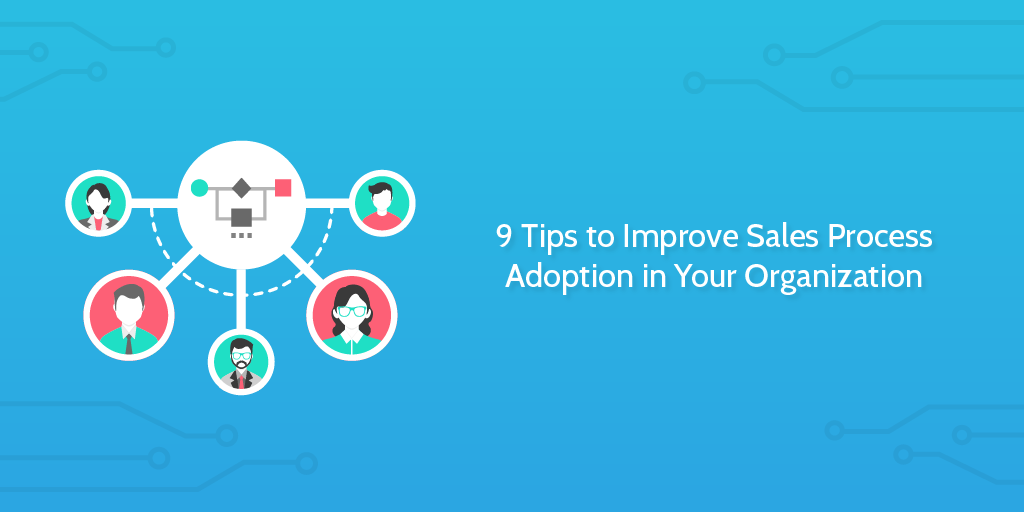
We all enjoy coming up with solutions. Unfortunately, if the solution needs to be internalized by a group of people to improve team execution, it can be a frustrating and time-consuming effort to get everyone on board.
Let’s say you have clearly identified that a process inefficiency is causing a bottleneck in sales productivity, and have built a solid process to address the issue. You’ve got the green light from senior management, they think it looks fantastic and can’t wait to see the impact it has.
Now, the real work begins – communicating the value of the process to your sales team and convincing them to implement it in their day-to-day work. Not as easy as it may sound.
Well, in this post I hope to relieve you of at least some of the stress that comes with sales process adoption by highlighting 9 tried and tested tips that will address 2 key obstacles you’ll face:
- Convincing sales reps that the process works and helps them achieve their sales goals.
- Providing the tools that enable reps to easily integrate the process into their day-to-day activities.
Successfully tick both those boxes, and you will be well on your way.
Let’s get started.
The challenge of sales process adoption
The difficulty of process adoption must not be underestimated, especially within a sales organization.
I say this because, as anyone else who has worked closely with salespeople would likely attest to, they can be rather stubborn individuals. This attitude can be largely justified by the fact that they have to be laser-focused on consistently meeting their quota each month.
It’s a tough job with high expectations, and so they are often unwilling to devote their time and attention to things that will not help them achieve their singular goal of closing deals.
Fair enough.
They have a lot on their plate and can’t afford to waste time trying to learn processes they see as being unhelpful or overly complex. In fact, a Gartner survey of over 2,000 reps found that 62% of perceived seller burden can be attributed to overly complex internal processes and procedures that reps are asked to follow.

Acknowledging the challenge before even beginning to convince reps to adopt a new process is absolutely essential. If you underestimate the challenge, it will show in your efforts and you may soon find yourself not being taken very seriously.
We don’t want that.
So, step 1 is to recognize the scale of the challenge that lies ahead, and shape your adoption strategy accordingly.
9 tips to get your sales team on board
1. Map out and evaluate your sales tool ecosystem
Make a list of all the sales and marketing tools in your tech stack.
Then, begin mapping out how each of the tools interacts with each other throughout the sales process. By doing so, you are mapping out the sales workflow from a technology perspective, which in turn allows you to see exactly how sales reps are expected to interact with the tools to follow processes and move leads down the funnel.
For example, the very beginning of an inbound sales process may be a form being filled out on a landing page. Then what happens? If you have numerous automation rules in place, how do they communicate and affect the tasks of sales reps?
Once you feel confident that you have mapped out your sales tool ecosystem, evaluate it with other sales and marketing managers to try and identify opportunities for optimization. There may be a tool that isn’t necessary and can be removed or an inefficient stage in the process that can be streamlined by introducing a new tool or approach.
Having a clear understanding of the sales process from a technology perspective is vital because you can then communicate with the sales team more effectively on exactly how they are expected to integrate the new process into their work.
However, this tip extends beyond the sole purpose of process adoption. The document you create, compressing the sales ecosystem into an A4 piece of paper, is an excellent reference for the whole team, and ideally should be pinned above everyone’s desk.
2. Centralize all information in your CRM

This is a rather obvious tip that you’ve likely read in other sales articles. We all know that CRM is the holy grail of sales and marketing management.
Regardless, it must be mentioned.
Your CRM should be a central source of information for the sales team that is always up-to-date. Such information should include:
- Customer order history
- Activities associated with sales (calls, emails, demos, inbound activity etc.)
- Customer support requests
- Issue resolutions
- Marketing analytics
Siloed data floating around in various tools creates avoidable inefficiencies that will make your job harder when trying to convince reps to adopt a new process.
Without centralizing information in an organized way, CRM adoption can become a significant challenge in and of itself. The 2018 Sales Operations Optimization Study conducted by CSO Insights, found that only 45.7% of participants reported an adoption rate of greater than 90%.
“Access to solid processes, robust systems and accurate data are necessary for salespeople to effectively do their jobs, not just in terms of forecast management, but also in nearly all the other activities with which they are tasked.” – CSO Insights
The art of selling provides salespeople with plenty of frustration as it is. When it comes to internal processes, they like things to be simple and straightforward. Make things simple, and you are considerably more likely to get their focused attention.
3. Understand the power of simplicity

This is an extension of the point I made in the previous paragraph – that salespeople like things to be simple.
Everything from the organization of your sales and marketing ecosystem to the way new marketing content is distributed needs to be simple and efficient if it is to be well understood by the sales team.
For a sales rep (or any employee for that matter), having a good understanding of how the team functions is a prerequisite to adopting a new process.
You may be aware that we here at Process Street are big fans of a man named Atul Gawande, who wrote a book called The Checklist Manifesto. Gawande is a writer and surgeon, who, in his book, details how medical surgeries, as well as other complex procedures, have a common tool that can greatly impact the quality of execution: a simple checklist.
We couldn’t agree more, Atul!
In order to adopt a process, one needs to know exactly what to do. Processes are built to be robust and are expected to be followed each and every time. Therefore, providing your sales team with a checklist guiding them through the new process is a great way to simplify it by breaking it up into digestible chunks; individual tasks progressing in sequence.
Even if you would rather not use checklists, remember to keep things simple. Put yourself in a sales reps’ shoes and think realistically about what you would need to be presented with if you were expected to change the way you work for a new process being implemented.
4. Clearly communicate the value of your process
A no-brainer, and yet, an aspect of sales process adoption that is often overlooked.
When communicating the value of your process to the sales team, these are some of the critical questions you must be able to answer with clarity:
- What bottleneck/shortcoming does the process address?
- How does it address this issue?
- Why is it better than the process used previously?
- How does it streamline the overall sales process?
- How does it help each individual salesperson achieve their goals?
- If fully adopted, what impact should we expect to see over the next 3-6 months on sales performance?
Answers to these questions should be communicated to the team in meetings, like a weekly sales all-hands for example.
It’s also important to encourage questions from the team. They may raise a concern that you or your managerial colleagues had not thought of, and you can discuss it together as a unit. This solves potentially unseen issues, and also builds trust with the team which is imperative to effective communication.
5. Make sure enablement content is easily accessible
Sales enablement content is designed to speak to the customer at various stages of the buyer journey. Rather than focusing solely on attracting buyers like most marketing content does, enablement content works to move leads and opportunities further down the sales funnel towards a closed won deal.
In other words, the content’s focus is on convincing rather than attracting.
Examples of good sales enablement content are:
- Product one-pagers
- Integration articles
- Case studies
- Competitive analysis
- Email templates
Following the creation of content, it’s imperative that the sales (and customer success) team have been clearly informed of:
- Where the content is located
- What value it communicates
- Guidelines on when and how to use it
The importance of accessibility is often overlooked. You may have great content out there but if the sales team can’t easily find it, it will be of no use. Research by SiriusDecisions shows that up to 65% of content goes unused. This is a significant bottleneck for sales productivity.
Salespeople like to work fast. The last thing they want to be doing is clicking through company files trying to find a specific case study or product sheet. It needs to be easily accessible.
One of the best ways to go about this is to ensure that all content is available from within your CRM or in your sales enablement software.
If you don’t have the technological resources to create a content library in your sales software, create a library in a Google Sheet, organized by type of content and stages of the buyer’s journey.
6. Always tie processes to sales goals

What will this process actually help achieve? Identify specific goals and tie them to the process so you can create a more compelling argument for why it should be adopted and can monitor progress down the line.
If you can’t nail down exactly how the process will forward sales goals, you may need to re-evaluate it and make adjustments accordingly.
In the best case scenario that the goals are exceeded, you can use that data to further convince the sales team, as well as senior management, that the process is working.
In the worst case scenario that everything falls apart when the process is implemented, you will still be left with valuable insights as to why.
Either way, tying processes to goals creates a win-win situation, or rather a win-learn situation depending on how you look at it.
7. Continuously refine your training program
Training new hires to become familiar with internal processes is essential to building a solid foundation for effective process adoption.
According to InsightSquared, you must standardize the following aspects of systems/processes when training new sales reps:
Sales process through the funnel
- CRM data entry
- Use of the technology stack
- Executing a proof of concept
- Onboarding a new customer
- A central repository for sales enablement
If sales reps don’t feel comfortable with each of these points, particularly the first three, you can hardly expect them to learn and adopt new processes that are introduced after their onboarding period.
8. Create a sales playbook
Just like your CRM should be the central repository of lead data, the sales playbook should be the one-stop shop for all information regarding your company’s value proposition, sales process, and guidelines on how to utilize various enablement materials reps have at their disposal.
“Above all else, a great playbook has to contain buyer-relevant messaging.” – Trish Bertuzzi, Founder and Chief Strategist of The Bridge Group
How does a sales playbook encourage process adoption?
Well, it clarifies in a formal, written document what those processes are and how they are expected to be used. It provides sales reps with another resource to understand how processes fit in with the overall sales strategy, and why it’s important to follow them.
9. Be patient, understanding, and listen

“The most basic of all human needs is the need to understand and be understood. The best way to understand people is to listen to them.” – Ralph G. Nichols
We are all humans at the end of the day. We make mistakes and all have different ways of internalizing things.
As a sales manager, being patient, understanding, and listening to your team are vital ingredients to being a good leader.
If your team feel that you have their back and consider their best interests, you will gain the trust that will ultimately result in processes being followed as you have instructed them to be.
17 free Process Street sales processes to accelerate growth
As I mentioned earlier, checklists are an awesome way to encourage employees to adopt processes and integrate them into their day-to-day work.
We’ve made a bunch of templates that will get you going on the right foot. Each template is fully customizable, so you can shape them according to how you get things done in your sales organization.
If you like what you see and want to use any of them, just click on “I want this for my business” button in the top right of the screen and it will be added to your organization within Process Street.
Here are 9 templates focused on sales execution. An additional 8 templates for account management processes such as sales forecasting, upselling, and churn prevention are also available for free.
Conclusion
The way I see it, there are two key components to successfully convincing your sales team to adopt a new process, whether it be a minor one like a cold calling process, or a major one, like the process for handing off a new buyer to the customer success team. I can safely say that these two points have been validated by the research I have conducted while preparing to write this post.
The first is the technology side of things; CRM usage, data entry, understanding the general flow of the sales process as it progresses through various tools in your stack. Simplicity is the key here.
The second, equally important component, is good old-fashioned communication. This includes conveying the value of your process in relation to sales goals, providing guidance on how to utilize the sales playbook and other enablement materials, and being open to feedback from all members of the team.
Ultimately, it’s good leadership that will get your team members following processes as you expect them to. If they don’t trust or respect you, why would they make the effort to change the way they work?
What kind of techniques do you use to encourage your team to adopt new sales processes? Which do you think work best? Let me know in the comments below!







Alex Gallia
Alex is a content writer at Process Street who enjoys traveling, reading, meditating, and is almost always listening to jazz or techno. You can find him on LinkedIn here